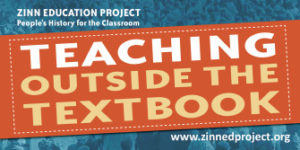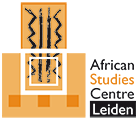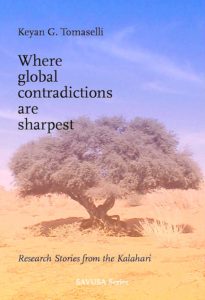Zinn Education Project ~ Tackling The Headlines: Teaching Humanity And History
 With each passing day, it’s becoming more apparent that Trump’s agenda can only be enacted if people are ignorant of the issues underlying his supposed solutions.
With each passing day, it’s becoming more apparent that Trump’s agenda can only be enacted if people are ignorant of the issues underlying his supposed solutions.
Having trouble finding and keeping work? – Build that wall.
Fearful of terrorist attacks? – Ban Muslims.
Want energy security and infrastructure development? – Build that pipeline.
The best antidote to Trump’s xenophobia, racism, misogyny, and fossil-fuel soaked future is critical thinking. Join the Zinn Education Project in helping students probe the roots of social problems and call into question the phony, simple-minded policy prescriptions of the Trump regime.
These are just a few of the resources we have at the Zinn Education Project to help students think deeply and creatively about the world we live in.
Use these resources with your students. Share them with your colleagues.
Support the Zinn Education Project
Immigration and Border Lines
 U.S. Mexico War: “We Take Nothing by Conquest, Thank God”
U.S. Mexico War: “We Take Nothing by Conquest, Thank God”
Today’s border with Mexico is the product of invasion and war. Grasping some of the motives for that war and some of its immediate effects begins to provide students the kind of historical context that is crucial for thinking intelligently about the line that separates the United States and Mexico. It also gives students insights into the justifications for and costs of war today. Teaching Activity by Bill Bigelow.
Go to: https://zinnedproject.org/teaching-humanity-history/
Other subjects:
-The Line Between Us: Teaching About the Border and Mexican Immigration
-Tackling Terrorism and Anti-Muslim Rhetoric. A People’s History of Muslims in the United States. What school textbooks and the media miss
-Whose “Terrorism”?
and more
ASCL Country Portal ~ Information About African Countries ~ News, Statistics, Maps, Images And More
 The ASC country portal provides a list of free internet resources and other information on Africa. It was initially set up for the general public but those with greater in-depth knowledge of Africa will also find some of the resources valuable. The ASC country portal aims to present information on each African country at a glance. The internet resources have been selected by staff at the African Studies Centre library.
The ASC country portal provides a list of free internet resources and other information on Africa. It was initially set up for the general public but those with greater in-depth knowledge of Africa will also find some of the resources valuable. The ASC country portal aims to present information on each African country at a glance. The internet resources have been selected by staff at the African Studies Centre library.
Corrections and suggestions are very welcome. Please contact: asc@ascleiden.nl
Go to: http://countryportal.ascleiden.nl/
YouTube Channel African Studies Centre Leiden
The African Studies Centre Leiden is the only multidisciplinary academic knowledge institute in the Netherlands devoted entirely to the study of Africa. It has an extensive library that is open to the general public. The ASCL is an interfaculty institute of Leiden University. The institute is located in the Pieter de la Court Building of the Faculty of Social Sciences of the University of Leiden, Netherlands.
YouTube channel: https://www.youtube.com/user/AfricanStudiesCentre
Published on May 19, 2015
Film about the workshop ‘Governance and Connections in Africa’s Contemporary Conflicts’ (19 March 2015) and public lecture ‘Globalised Conflict Situations – Nigeria’s Boko Haram in Perspective’ by Egosha E. Osaghae, Professor of Comparative Politics and Vice Chancellor of Igbinedion University, Okada, Nigeria (20 March 2015). Organized by the African Studies Centre in Leiden.
Exposing The Myths Of Neoliberal Capitalism: An Interview With Ha-Joon Chang
For the past 40 years or so, neoliberalism has reigned supreme over much of the western capitalist world, producing unparalleled wealth accumulation levels for a handful of individuals and global corporations while the rest of society has been asked to swallow austerity, stagnating incomes and a shrinking welfare state. But just when we all thought that the contradictions of neoliberal capitalism had reached their penultimate point, culminating in mass discontent and opposition to global neoliberalism, the outcome of the 2016 US presidential election brought to power a megalomaniac individual who subscribes to neoliberal capitalist economics while opposing much of its global dimension.
What exactly then is neoliberalism? What does it stand for? And what should we make of Donald Trump’s economic pronouncements? In this exclusive interview, world-renowned Cambridge University Professor of Economics Ha-Joon Chang responds to these urgent questions, emphasizing that despite Donald Trump’s advocacy of “infrastructure spending” and his opposition to “free trade” agreements, we should be deeply concerned about his economic policies, his embrace of neoliberalism and his fervent loyalty to the rich.
C. J. Polychroniou: For the past 40 or so years, the ideology and policies of “free-market” capitalism have reigned supreme in much of the advanced industrialized world. Yet, much of what passes as “free-market” capitalism are actually measures designed and promoted by the capitalist state on behalf of the dominant factions of capital. What other myths and lies about “actually existing capitalism” are worth pointing out?
Ha-Joon Chang: Gore Vidal, the American writer, once famously said that the American economic system is “free enterprise for the poor and socialism for the rich.” I think this statement very well sums up what has passed for ‘free-market capitalism’ in the last few decades, especially but not only in the US. In the last few decades, the rich have been increasingly protected from the market forces, while the poor have been more and more exposed to them.
For the rich, the last few decades have been “heads I win, tails you lose.” Top managers, especially in the US, sign on pay packages that give them hundreds of millions of dollars for failing — and many times more for doing a decent job. Corporations are subsidised on a massive scale with few conditions — sometimes directly but often indirectly through government procurement programs (especially in defense) with inflated price tags and free technologies produced by government-funded research programs. After every financial crisis, ranging from the 1982 Chilean banking crisis through the Asian financial crisis of 1997 to the 2008 global financial crisis, banks have been bailed out with hundreds of trillions of dollars of taxpayers’ money and few top bankers have gone to prison. In the last decade, the asset-owning classes in the rich countries have also been kept afloat by historically low rates of interests.
In contrast, poor people have been increasingly subject to market forces.
In the name of increasing “labor market flexibility,” the poor have been increasingly deprived of their rights as workers. This trend has reached a new level with the emergence of the so-called “gig economy,” in which workers are bogusly hired as “self-employed” (without the control over their work that the truly self-employed exercise) and deprived of even the most basic rights (e.g., sick leave, paid holiday). With their rights weakened, the workers have to engage in a race to the bottom in which they compete by accepting increasingly lower wages and increasingly poor working conditions.
Read more
Where Global Contradictions Are Sharpest ~ Research Stories From The Kalahari ~ Contents
 The ‘Bushmen’ or ‘San’ of the Kalahari could well be called an iconographic people. Partly as a result of this, over the years abundant social research has been carried out among the San. Keyan Tomaselli and his research team from the University of KwaZulu-Natal in South Africa form part of that tradition; however, in this book Tomaselli is also able to reflect critically, and not without a touch of irony, on the way the San have been represented over the years. Hardly ever has there been a researcher who so uncompromisingly and aptly illustrates the many ethical contradictions in doing fieldwork among the San, and at the same time manages to reconstruct and represent the actual fieldwork experience and the San people so vividly that you almost taste the dust of the Kalahari and smell the raucous world that is depicted.
The ‘Bushmen’ or ‘San’ of the Kalahari could well be called an iconographic people. Partly as a result of this, over the years abundant social research has been carried out among the San. Keyan Tomaselli and his research team from the University of KwaZulu-Natal in South Africa form part of that tradition; however, in this book Tomaselli is also able to reflect critically, and not without a touch of irony, on the way the San have been represented over the years. Hardly ever has there been a researcher who so uncompromisingly and aptly illustrates the many ethical contradictions in doing fieldwork among the San, and at the same time manages to reconstruct and represent the actual fieldwork experience and the San people so vividly that you almost taste the dust of the Kalahari and smell the raucous world that is depicted.
Note on the Author
Keyan G. Tomaselli is Professor in Culture, Communication and Media Studies, University of KwaZulu-Natal, Durban. He is a Fellow of the University and serves on the advisory board of !Kwa ttu – The San Cultural and Educational Centre. He is Old World book review editor of Visual Anthropology, and has published on visual anthropology in this and other publications such as Appropriating images: The semiotics of visual representation (Intervention Press, 1999). Other journals in which Tomaselli has published include: Visual Studies, Cultural Studies, Journal of Film and Video, Research in African Literatures, etc. He is published in translation in Italian, Spanish, French, Italian, Portuguese and Arabic, amongst others. Tomaselli is editor-in-chief of Critical Arts: A Journal of South-North Cultural and Media Studies.
Contents
Acknowledgements, Acronyms, A Note on Pronunciation
Starting Off – Different people, different communities – Specifically, what are we doing?
Chapter 1. Negotiating Research with First Peoples
Chapter 2. Reverse Cultural Studies: Field Methods, Power Relations and 4X4s …
Chapter 3. ‘Dit is die Here se Asem’: The Wind, its Messages, and Issues of Autoethnographic Methodology in the Kalahari
Chapter 4. ‘Op die Grond’: Writing in the San/d, Surviving Crime
Chapter 5. Psychospiritual Ecoscience: The Ju/’hoansi and Cultural Tourism
Chapter 6. Textualising the San ‘Past’: Dancing With Development
Chapter 7. Stories to Tell, Stories to Sell: Hidden transcripts, negotiating texts
References
© Keyan G. Tomaselli, 2005
Cover photograph: Frederik J Lange (Jnr). Taken between Witdraai and Welkom, Northern Cape, June 2005.
Coverdesign: Ingrid Bouws, Amsterdam
Editing: Saskia Stehouwer
Published by Rozenberg Publishers, Amsterdam, 2005, ISBN 90 5170 481 X
Where Global Contradictions Are Sharpest ~ Acknowledgements, Acronyms, A Note On Pronunciation
 Acknowledgements
Acknowledgements
The research on which this book reports is greatly indebted to The Protea Hotel, Upington, for sponsorship of accommodation on the way to and back from the Kalahari. Riann and Jeannne de Klerk, Bill and Kathy Fisher, and Kathleen and Willie Burger provided other accommodations in Upington at one time or another. Thanks to the Molopo Lodge for dealing with our often-idiosyncratic requests, like students having to study and write exams during fieldtrips.
To Bronwyn Spicer, who worked as my editorial assistant on this book, my abiding and enduring appreciation. Thanks to Kamini Moodley, the project’s research manager, who worked hard and diligently behind the scenes, and also assisted with copyediting. In field trip and research management Kamini was preceded by Vanessa McLennan-Dodd, and Chantel Oosthuysen. My thanks also to Catherine Dunphy for copyediting. Nelia Oets was a superb camp provider, translator and co-researcher. Nelia was always ready to volunteer her 4X4 for our visits to the Kalahari and assisted in many other roles. Our research team could not have accomplished as much as it did without her consistent and systematic support – both in material resources and intellectually. Thanks to all my students and research affiliates who contributed to the project over the ten-year study period. All have been an inspiration to me and have provided significant depth to the analysis. (A second strand of this project has been conducted in Zululand, not reported on here.) Contributors are listed in Table 1 in Chapter 2 together with the their publications and thesis titles. A special mention must go to Mary Lange who acted as facilitator, translator, and advisor and who brought a unique empathy to our research relations with our hosts. Arnold Shepperson was an ever-present intellectual source in both this and other of our publications on the topic. Thanks to all our partners in the Kalahari, Belinda Kruiper, Roger Carter and all those who engaged in discussion with us. Paul Rodda provided computer support.
The research was partly funded by the University of Natal’s Research Fund, now the University of KwaZulu-Natal. The National Research Foundation also funded it: Social Sciences and Humanities. Opinions expressed and conclusions arrived at are those of the author and not the Foundation. An UKZN-based Mellon Post-doctoral Fellowship enabled Matthew Durington to join the project for 18 months. His critique of an earlier draft of Chapter 2 proved very helpful. The research was started while I was a Fulbright researcher in the African Studies Center, Michigan State University, 1990-1, working on its African Media Program.
Other organisations which facilitated aspects of our research at one time or another include the Department of Anthropology, Smithsonian Institution; Documentary Educational Resources; the Working Indigenous Minorities Group; the South African San Institute; the Nquaa Khobee Zeya Trust, the Kuru Development Trust; and Rob Waldron.
I must also mention Jake Homiak whose early support via the Smithsonian’s Human Studies Film Archives underpinned the early stages of the research. Others on whom my students and I have drawn include John and Lorna Marshall, Cynthia Close, Fiona Archer, Nigel Crawhall, Meryl-Joy Winschutt, amongst many others. I am also deeply appreciative of the sustained support and encouragement for our autoethnographic turn offered by Norman Denzin of the University of Illinois, Urbana-Champaign. Thanks also to Frans Prins, Bob Hitchcock, Garth Allen, Megan Biesele, Dave Wiley, amongst many others, who have liaised with me and some of my students on our work.
Chapter 1, ‘Negotiating Research with First Peoples’, is revised, adapted and updated from Shepperson, A. and Tomaselli, K.G. (Eds) (2003), ‘From one to an-other: Auto-ethnographic explorations in Southern Africa’, Cultural Studies – Critical Methodologies, 4(4). Chapter 2 is a very extensively updated, totally revised and much elaborated version of my earlier article, ‘Blue is hot, red is cold: Doing reverse cultural studies in Africa’, first published in Cultural Studies – Critical Methodologies, 1(3), 2001. Chapter 3, ‘Dit is die Here se Asem: The Wind and its Messages’ is adapted from Cultural Studies – Critical Methodologies, 3(4), 2003. Chapter 4, ‘“Op die Grond”: Writing in the San/d, Surviving Crime’, is revised from Current Writing: Text and Reception in Southern Africa, 15(3), 2003. Chapter 5, ‘Psychospiritual Ecoscience: The Ju/’hoansi and Cultural Tourism’, and Chapter 6, ‘Textualising the San “Past”: Dancing with Development’, are revised from Visual Anthropology, 12(3/4), 1999. Chapter 7, ‘Stories to Tell, Stories to Sell: Resisting Textualisation’, is adapted, revised and updated from Cultural Studies, 17(6), 2003. My thanks to the various publishers for permission to rework these articles into this book.
Keyan G. Tomaselli, August 2005
Acronyms
- CCMS Culture, Communication and Media Studies (University of KwaZulu-Natal) (Howard College Campus, Durban)
- CKGR Central Kalahari Game Reserve
- IGWIA International Working Group for Indigenous Affairs
- CPA Community Property Association (Based in Andriesvale)
- CRAM Cultural Resources Auditing and Management Project
- JFP Jesus Film Project (Based in Kimberly)
- LIFE Living in a Finite Environment Program
- NNDFN Nyae Nyae Development Foundation of Namibia (Based in Windhoek)
- NNFC Nyae Nyae Farmers’ Cooperative (Based in Baraka)
- SABC South African Broadcasting Corporation
- SASI South African San Institute (Based in Kimberley)
- SBB Safaris Botswana Bound (Based in Maun, operating in KD/1 Area)
- SI Survival International
- SIM Serving in Mission
- SACOD Southern African Communications for Development
- SWAA South West African Administration
- SWAPO South West African People’s Organisation
- WIMSA Working Group for Indigenous Minorities in Southern Africa (Based in Windhoek, Namibia)
A Note on Pronunciation
All !Kung and San languages have clicks, which are additional consonants. The most commonly used clicks are:
≠ Alveolar click made by sucking the tongue against the ridge behind the upper front teeth.
// Lateral click made at the side of the mouth.
! Palatal click made by clicking the tongue on the roof of the palate.
For further information on language see Dickens and Traill (1997); Dickens (1992); Barnard (1992: xix-xxii).



